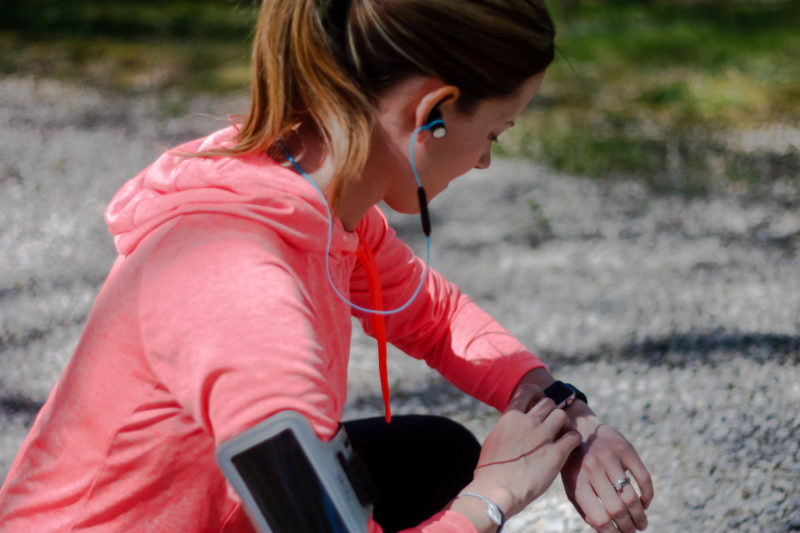Fitness trackers have become one of the most popular consumer items in the last 5 years. Over 310 million of these wearable devices (Fitbit, Apple Watch, etc) were sold in 2017 generating over 30 billion dollars in sales.
I’ll be the first one to admit I love my Apple Watch. While my husband feels strongly he needs every new Apple gadget available, this was kind of an out of character purchase for me as my watches typically come from Target and cost less than $30. I was quickly converted, however, and now I’m not sure I’ll ever go without a smartwatch. The best feature, in my opinion, is the quick alerts and text, which allow me to not have to have my phone next to me 24-7. Before, especially if I was on call, I would always have my phone right next to me to ensure I never missed a page. This allowed me to be easily distracted by my phone. Now I am alerted if I have an email or message from work, friends or family and can decide if I need to respond right away or if something can wait. I no longer feel the need to have my phone constantly at my side and subsequently spend much less time on it.
One app I have rarely used on my watch, however, is the activity tracker. I simply can’t get into it. The main reason, as I’ve discussed in previous posts, is that weight loss and fitness are not achieved by trying to identify exactly how many calories you eat and exactly how many calories you burn. Remember, there’s no way you’re able to calculate this down to an exact calorie measurement. And even if you could, I have about as much faith in the accuracy of these devices as I do in the calculator on the treadmill at the gym. As it turns out, studies have shown most of these trackers really don’t have much to stand on when it comes to helping people achieve health goals. A recent study found they are reasonably accurate with detecting heart rate, within a 5% margin of error for most. But they are wildly inaccurate when it comes to calculating energy expenditure, or calories burned. This study looked at 7 popular devices (Apple Watch, Basis Peak, Fitbit Surge, Microsoft Band, Mio Alpha 2, PulseOn, and Samsung Gear S2) and found that none came within a 20% margin of error when it came to calculating energy expenditure. The best was off by 27 percent, and the worse was off by 92 percent. 92 percent!

Another function I hear people mention frequently is their sleep, which these devices claim to track. Many of the monitors use an accelerometer to determine if you are asleep or awake. This can be inaccurate because movement does not always distinguish accurately between sleep and wake periods. It also can’t distinguish between heavy and light sleep because there is movement during both. They cannot accurately measure REM sleep. REM sleep is determined by brainwaves and is only detectable with a polysomnography test which measures brain waves, eye movements, muscle activity and heart rhythm. Most commercial trackers use only accelerometers, and some combine this with heart rate to estimate time in REM, but this is not enough information to provide accurate data. Here’s a quick and free test to tell if you’re getting quality sleep: are you getting at least 7 hours and do you feel rested during the day? No to either of those tells you there’s a problem. It’s really as simple as that!
So if they’re not useful in calculating calories burned, or tracking sleep, should I even bother with one? I think there still may be a place for them.
When I do nutrition or health coaching, I encourage people to listen to their bodies when it comes to movement (exercise). Think about a day when you’ve been sitting for hours on end and your brain says “man, it would feel good to get up and walk around.” As you learn to identify and listen to cues like this you can experience them across a wider spectrum. You learn to recognize when your body desires an intense workout versus some light stretching, a brief walk, or something like yoga. If your body is overworked and overstressed on a particular day, working out can actually be detrimental to your health goals. However, for many people, it’s difficult to recognize these cues, especially when they first start a fitness plan. Having a fitness tracker may be beneficial in giving you a general idea of how much you’ve moved on a particular day compared to your normal, and that can be helpful. You can use it to recognize this and then decide the best workout or movement for you to do that day. I would not recommend trying to micromanage your workout based on your “steps” for the day.
Trackers can also be useful if you are training for a race, trying to increase your pace, or simply tracking your distance. Just because I don’t encourage calculating calories burned doesn’t mean you can’t challenge yourself to run further or faster, or as a tool to get your miles in for a training regimen. The GPS offered on some of these devices are very useful for that. In fact, this is probably the only time I utilize the workout app on my Apple Watch.

You may also appreciate the many other apps available on your smartwatch or tracker which provide value. I frequently use my wireless headphones to listen to music or an audiobook and love the ability to control the player through my watch instead of on my phone. I like having a quick calendar view available at the flip of my wrist. I love getting text and email alerts without having my phone in my hand. And my most used app by far is the alarm to find my phone since I no longer have it on me every second of the day and I never know where it is when I need it.
If you love it, great. Use it. But don’t stress over your steps and don’t rely on their accuracy for how many calories you’ve burned. Learn to listen to your body and it’s desire to move because your mind is a far more accurate detector of what you need than an electronic device.





